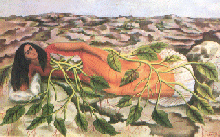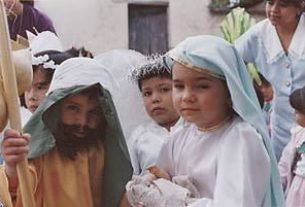Mexico City in the 1920s stood on the threshold of a new era. Although the country had won its independence from Spain in 1821, it became obvious by the early 1900s that the economic gap between rich and poor—and the social gap between the Spanish-descendant and Amerindian-descendant—had only increased following the departure of the Spanish. Sparked by the populist escapades of colorful bandit-turned-revolutionary Francisco ‘Pancho’ Villa and peasant-hero Emilano Zapata, Mexico endured a decade of civil war before the newly established Partido Revolucionario Nacional (PNR) began steering the nation in a new, socialist-inspired direction in 1920. The capital swarmed with optimism as the PNR vowed to make mestizaje—the blending of Amerindian and European patrimonies—the national zeitgeist. For Mexico, and especially for the intellectuals, artists and academicians of Mexico City, the armed battles had ended but the cultural struggle was just beginning.

Under the 1920-24 presidency of Alvaro Obregón, the government decided that public works of art could play an important role in restoring a nationhood tattered by civil war. Commissioned to create a number of murals at the National Preparatory School at the University of Mexico in 1922, painter Diego Rivera took on the task of conceiving a new art medium that avoided a Eurocentric orientation and instead celebrated Mexican heritage from early Mesoamerica through the Revolution. He was joined by a number of other similarly commissioned Mexican artists, who together formed the Syndicate of Technical Workers, Painters, and Sculptors. In a public tract issued by the Syndicate in 1922, fellow muralist José Alfaro Siqueiros urged Mexican artists to “repudiate so-called easel painting and every kind of art favored by the ultra-intellectual circles, because it is aristocratic, and praise monumental art in all its forms, because it is public property.”

While the colonial art of Mexico and Latin America had from time to time, incorporated Indian decorative motifs—sculpting squash foliage or pineapple patterns in stone to fill the space between religious figures on churches and cathedrals, for example—the overall design concepts, styles, and techniques employed were always Spanish. A painted bodegón or pantry scene might contain corn and cacao instead of oranges and grapes yet it remained the patented European still life, muted in color and devoid of human presence.
The Mexican Modernist School abandoned the solemn and detached art of Europe and instead embraced bold New World imagery full of color and human activity. Looking for a medium beyond the confines of canvas and church porticoes, they settled on the vast, undecorated walls of Mexico’s governmental edifices. Like the Aztecs and Mayans of earlier eras, who painted on the walls of their temples and tombs, the Mexican muralists left their public buildings awash with color. And like their Mesoamerican predecessors, they took native subjects as their inspiration. Instead of creating portraits of Spanish aristocrats, they glorified the everyday lives of the contemporary Amerindian population; in place of Franciscan friars fingering rosaries, they painted peasants tilling the soil.
Although many Mexican artists participated in the muralist movement, three names quickly came to the fore in Mexico City: Diego Rivera, David Alfaro Siqueiros, and José Clemente Orozco. One of Rivera’s earliest mural efforts emblazoned the courtyard of the Ministry of Education with a series of dancing tehuanas (natives of Tehuantepec in southern Mexico). This four-year project went on to incorporate many other contemporary Amerindian themes, and it eventually encompassed 124 frescoes that extended three stories high and two city blocks long. Such prodigious output, along with the predominance of native elements, had a profound effect on the Mexican art scene.
Janet Bishop, associate curator of the San Francisco Museum of Modern Art (which recently hosted a collection of easel paintings by Rivera, Siqueiros, and others from the Mexican Modernist School), says the muralist movement was part of a Mexican cultural renaissance that indicated a letting-go of European influence. “Mexican artists of the 1920s through the 1950s had a huge impact on art throughout the Americas as they strove to reach the Mexican people through legible, immediate imagery, moving away from avant-garde abstraction to realistic portrayals of Mexican life. The muralists were more interested in pre-Cortesian art and native imagery than in impressionism, cubism, surrealism or any of the other European art concepts of the time, aiming instead for a regaining of Mexican consciousness and a tying together of Mexican roots and contemporary culture.”

Rivera and company revived the fresco, a watercolor medium that depends on the transparency of layered colors washed onto damp plaster, which absorbs the pigment to form a calcium carbonate film impervious to water and light. Siqueiros began with fresco, but soon moved toward industrial techniques and materials such as the thick application of pyroxilin, a commercial enamel used for airplanes and automobiles. Mexican experimentation with new pigment mediums during this period produced the acrylic paint used by amateur and professional artists around the world today.
Although Rivera and Siqueiros achieved international prominence through their public art works, Orozco became the modernist movement’s real vanguard. Unlike Rivera and Siqueiros, who publicly disavowed European-style easel art yet continued to accept private commissions for canvas paintings, once Orozco had pledged membership to the Syndicate, he destroyed all his earlier canvases and devoted himself to the ideals of social art for the remainder of his life. According to Bishop, “Orozco always resented Rivera for creating works in response to collector interest.”
Rivera remained a controversial and politicized figure throughout his career. When in 1933 Nelson Rockefeller decided he wanted a mural for the new RCA Building at Rockefeller Center, New York, he commissioned Diego Rivera (after receiving refusals from Picasso and Matisse). Thumbing his nose at the Western world’s primary proponent of free enterprise, Rivera chose to depict the modern worker at a symbolic junction of science, industry, capitalism, and socialism in a work provisionally entitled ‘Man at the Crossroads Looking with Hope and High Vision to the Choosing of a New and Better Future’.
Among several influential world personalities portrayed in the fresco—including Edsel Ford, Jean Harlow, and Charlie Chaplin—Rivera included a figure of Russian communist leader Vladimir Lenin. When he steadfastly refused Rockefeller’s request to remove Lenin’s portrait, Rockefeller had the entire fresco chiseled off the wall. Rivera later reproduced the mural in its entirety on an interior wall of the Palacio de Bellas Artes in Mexico City, where it can still be seen today.
But as famous as the Mexico City murals made him and his colleagues, a star-crossed romance with a young National Preparatory School student drew Rivera into a living tableau that for much of the world has symbolized the 20th-century Mexican art milieu seemingly for all eternity. Kahlo and Rivera married in 1929 and nearly overnight became a charismatic, celebrated couple on the art and society circuit around Mexico, the United States, and Europe. Their tumultuous relationship and Rivera’s notorious infidelity only seemed to propel their mythic status. “I have suffered two accidents in my life,” Kahlo is quoted as saying in the biography, Frida Kahlo: Torment and Triumph in Her Life and Art, written by Malka Drucker. “One in which a streetcar ran over me [at age 18]. The other is Diego.”

The aftermath of the streetcar accident, including over 30 surgical procedures and 28 plaster corsets designed to support her damaged spine, form a recurring theme in Kahlo’s famous self portraits. But more than the sometimes tortuously clinical details in these autoretratos, it’s her iconic facial features—the batwing eyebrows, the stern, rose-like mouth, and secretive, sidelong glance fixed on the viewer—that one most remembers. A pronounced sexual ambiguity is also often present. In one portrait she suggests androgyny by merging her face with Diego’s while another portrays Kahlo sporting shorn hair and a man’s suit and tie. In a now-famous family photo from 1926 her hair is pulled back tightly and she again is dressed like a man.
In spite of her preference for personal rather than overtly political themes, Kahlo’s work formed a central part of the Mexican Renaissance in its employment of native Mexican elements. Many of her paintings show an influence rooted in the tradition of Mexican religious folk culture, yet in a sense her work was post-modernist since she didn’t completely turn away from traditional European presentation concepts. In ‘The Little Deer’ (1946), Kahlo superimposed her head on the body of a stag (once again blending genders), whose body is pierced by numerous arrows. The painting recalls the martyrdom of St. Sebastian—a popular European theme in medieval religious art—while evoking the danza del venado, a mythic deer-hunting dance ritual common among Amerindian tribes throughout Mexico.
Although she didn’t participate in public works of art like the muralists—in her physical condition she could hardly be expected to mount scaffolds—Kahlo in her own way became just as influential in her promotion of Mexican cultural nationalism. She decorated her home not with European and American art and accessories, but with Mexican handicrafts and folk art. Rivera and his colleagues typically dressed in the European fashions of the day, while Kahlo, though born of a German immigrant father, most often wore Amerindian dresses, shawls, and jewelry. Although she was born in 1907, she usually gave 1910—the year the Mexican Revolution began—as her birth date.

Kahlo died in 1954, and Rivera followed her three years later. Of all the Mexican artists who have worked in the 20th century, Diego and Frida are the most loved and remembered. In spite of the dynamic couple’s original living legend status, over the last decade Kahlo’s international reputation has grown beyond that of her contemporaries as well as that of her husband Rivera. At a recent San Francisco Museum of Modern Art exhibition of the Gelman Collection—one of the largest private collections of paintings by the Mexican Modernists—museum-goers paid scant attention to paintings by Rivera, Siqueiros, and Orozco, but they stood four deep around the Kahlo paintings. According to Janet Bishop, curator of the exhibit, “Interest in Kahlo today has possibly eclipsed recognition of the three great muralists. People respond to the fact that although Kahlo experienced a great deal of physical and mental pain, she produced potent works of art. They are struck by her resilience, and also identify with her clear fascination with self.”
What, if any, legacy have the Mexican Modernists left to younger artists working in Mexico City today? According to Museo de Arte Moderno director Teresa del Conde, the nationalism of the Mexican Modernist School has been replaced by neomexicanismo, a slightly surreal, somewhat kitsch and postmodern slant on popular rather than historical Mexican culture. Just as Rivera turned to literal painting after his experiments in avant-gardism, surrealism and cubism, artists in Mexico City seem to be favoring representational art nowadays. Fifty-five young artists awarded scholarships from the Consejo Nacional para Cultura y las Artes recently exhibited at the Museo de Arte Carrillo Gil; their work ran the gamut from abstraction to neo-figuration. “The one characteristic of this generation is that we like to work in the representational, figurative style,” said scholarship painter Victor Rodríguez of the group in an interview published in the Mexico City Times. “There’s not much abstract art here.”















